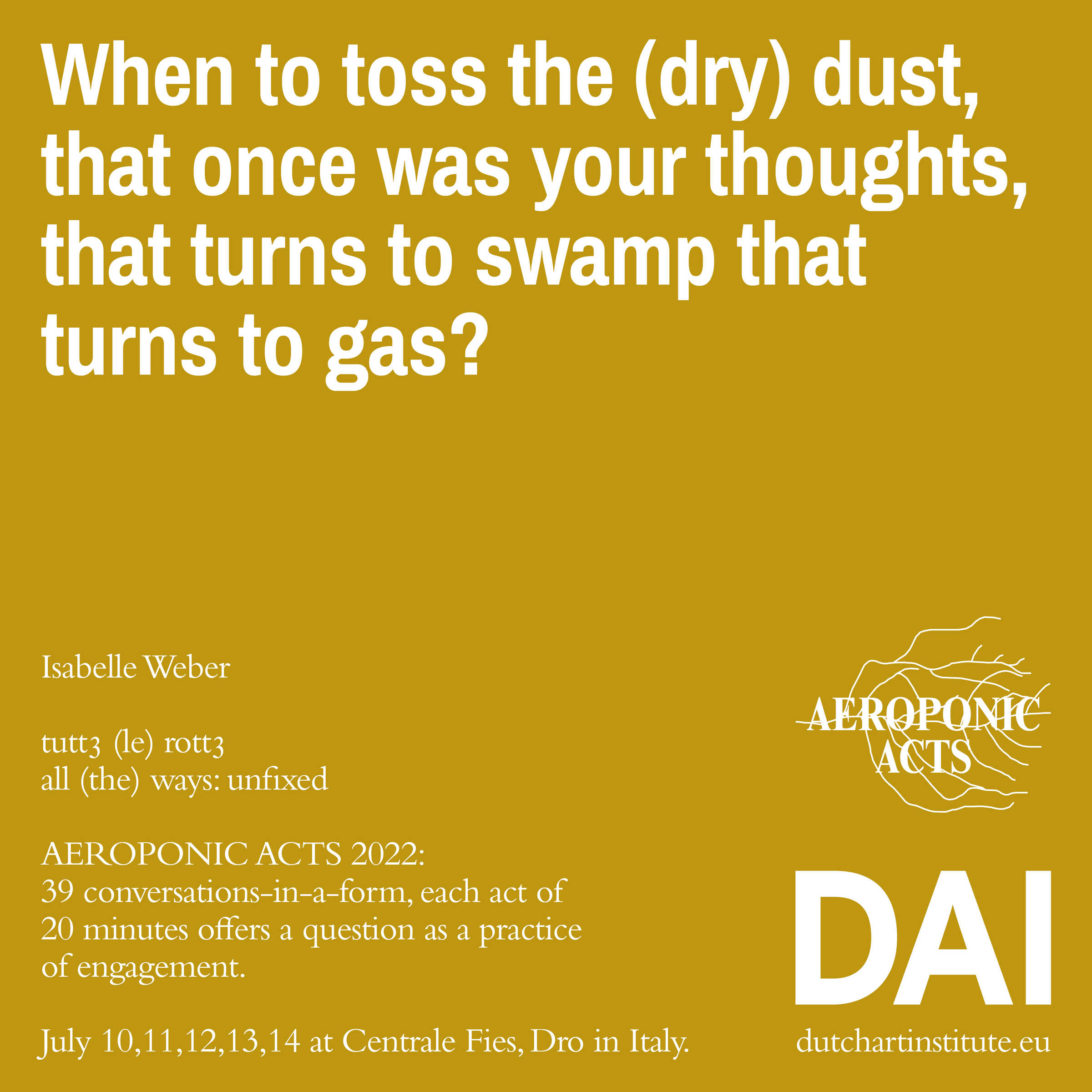Isabelle Weber: Clouds nest like cysts on the soft tissues of their hosting milieu
‘Aeroponic’ – root systems nourished by air – Acts is the name given to the nomadic Dutch Art Institute’s final Kitchen presentations. Each participant addresses one question, as a practice of engagement.
Here you will find the documentation of Isabelle Weber's presentation as filmed by Baha Görkem Yalım. The written report is by Hubert Gromny and it includes a summary of the comments by esteemed guest respondents.
Clouds nest like cysts on the soft tissues of their hosting milieu
Isabelle's question: when to toss the (dry) dust, that once was your thoughts, that turns to swamp that turns to gas?
Isabelle's introduction: Your mine-eyes mirror: a dark site on remote control. A blob of ether, a cloud of confusion, yellow dust sets onto a murky swamp. The granular, hissing, forms a riverbed to flush out data mines’ pixel. Hot spots in a cool place: the datasphere is alive with corporate chunks of imperial extraction. “Dig that bit there, coin!” And in that necrotic foggy zero- energy-state, you and I have never been so close.
With the participation of Alexandra Martens Serrano (DAI 2022), Emmeli Person (DAI 2022), Izaro Ieregi (DAI 2022), Maud Gyssels (DAI 2022) and Mirjam Steffen (DAI 2022). Sound: Maud Gyssels (DAI 2022).
Hubert's report: The audience enters the spacious, bright room transformed into a performative installation. There are pillow-like sculptures covered with yellow, marble-patterned textile, golden puddles made of semi-transparent plastic. Performers (Alexandra Martens Serrano, Emmeli Person, Izaro Ieregi, Maud Gyssels and Mirjam Steffen) are lying on the floor and looking at screens of phones and tablets. Alexandra Marten’s Serrano’s head is placed in the plexi-glass orange box with her hair interlaced through holes and being braided by Emmeli Person. Few TV screens distributed in the space presenting synthetic digital landscapes and text. The room is foggy due to the use of smoke-machine. The ambient music comes out of the speakers accompanying the minimal movements of the performers. Some engage with each other in a form resembling contact improvisation—they place weight upon each other and prepare for the next move. At moments performers are reading the text out loud, but for most of the time they remain still and quiet. The audience circulates within the space creating small gatherings around TV screens. At the end of performance Isabelle moves towards the windows and opens them. The attention of the viewers is directed to the outside where smoke-tubes were opened and produces the yellow and green fumes.
Phanuel Antwi pointed out the contradiction presented in the piece. By drawing attention to the engagement between bodies through their major parts such as elbows, ankles, hips and chest, the piece seems to be searching for a return and recovery, for an ability to access different ways of knowing. While placing this desire within the discourse on digital colonialism it is important not to separate wanting to find a way from actually finding one. The language of the piece was very much in relation to the body and the question on how bodies engage with each other. It avoided rendering colonialism a metaphor imposed on the realm of the digital. The contradiction of the piece lies in the way of entry. To see colonialism not as a metaphor would demand to see another history of Europe, which is not rooted in the ongoing colonial project. It would be interested in de-centering the colonial history of Europe to break the impression that it is the only possible one. This would allow us to look at landscapes not as sites of extraction or military operations but as something else, something beyond colonial rendering of the land.
Ana Teixeira Pinto noticed the tension present in the work and proposed to understand it through the history of the sublime in philosophy of aesthetics. The sublime marks the form of transcending power and participates in creating a distinction, which German enlightenment called “a fetishism”. In this work the sublime comes back as a technological gaze, digital frontier and aesthetics of posthuman art. The videos are presenting the digital dimension of colonial sublime. At the same time the videos are intersected with gender dimension and refer to the animal life and post-life as a spectrum. These two sides produce a tension as a result of a non-resolved relationship between declaring a position against extraction, but sustaining the aesthetics, which is an outcome of extractivism.
Chiara Figone recalled a documentary series Decolonisations (Marc Ball, Karim Miske) as an example of how it is possible to change perspective on looking at colonial history. The film series carries the question Chiara would like to pose for Isabelle's presentation. Describing the experience of moving in the space, Chiara spoke about her reflections on the experience of the captivated body. In this context the grappling questions are: how complicit is the form and how to move away from presenting that form of oppression, what are other possibilities of tackling same histories without forgetting inevitable positionality? Chiara noted that there is more to it than a question of complicity, it was hard not to be aware of the position one has during the performance. For the form, which is aimed to create an awareness the question should be posed if this awareness is not out there already? How the use of the materials which marks oppression could be disentangled by acknowledging the perspective of the body, which is captivated by these materials?
Isabelle Weber's "Clouds nest like cysts on the soft tissues of their hosting milieu" was presented before live audience at the Centrale Fies, Dro, Italy on July 10th.
Find the overview of all 24 AEROPONIC ACTS 2022 here: tuttə (le) rottə - all (the) ways: unfixed


